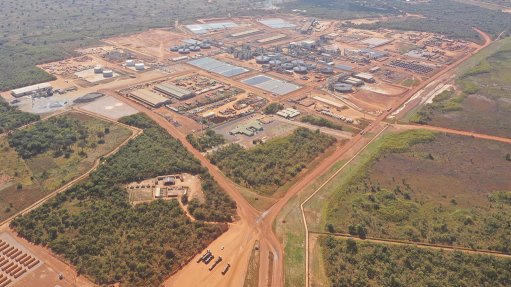Pig-iron plant construction expected to start in 2015


PROVING POTENTIAL Baobab Resources’ 759-million-tonne global pig-iron resource can potentially increase production from one-million tonnes to four-million tonnes a year
Photo by Bloomberg
Mozambique-focused exploration company Baobab Resources aims to complete the definitive feasibility study (DFS) for its flagship pig-iron and ferrovanadium project in the country’s Tete province by the end of this year, says Baobab Resources MD Ben James.
Meanwhile, the company is conducting pilot-scale pyrometallurgical and reduction tests on bulk samples of the project’s Tenge oxide iron-ore.
“Baobab Resources is confident that it will meet the milestone of completing the technical aspects of the definitive feasibility study,” says James, adding that the company is also on track with regard to government and stakeholder agreements, required compliance processes, mining licensing approvals, environmental-impact assessment (EIA) submission and social responsibility projects.
Baobab is also completing an updated marketing strategy for the project and is actively pursuing a strategic partner to ensure financing for the project. James tells Mining Weekly he expects construction of the plant to start in the second half of next year and to be completed by the beginning of 2017.
“This projected timeline is in line with the power and infrastructure expansions in the region,” he comments, adding that production of the pig-iron plant is also expected to start at the beginning of 2017.
The prefeasibility study on the Tete-based project, completed in March 2013, confirmed a strategic asset of global significance, based on a one-million-tonne-a-year pig-iron operation over a minimum 20-year life-of-mine (LoM), according to Creamer Media’s Research Channel Africa.
However, James believes there is opportunity for expanded mine production, as the project, with its current DFS estimating an LoM of 37 years, will result in the development of 110-million tonnes of ore, which is less than 15% of the global 759-million- tonne resource base at the Tete project.
“We believe we are not looking at a 20-year project, but a 100-year or 200-year multigenerational project, with significant opportunity for production expansion from one-million tonnes a year to four-million tonnes a year, which would make Baobab Resources one of the world’s largest pig-iron producers,” James emphasises.
In addition, the company is working towards a more accurate estimate regarding the cogeneration potential of its pig-iron plant.
“Baobab Resources should be able to cogenerate a minimum of 30% of its total power requirements, possibly even 60% or more, which is in line with its expectations and certainly with other rotary kiln operations worldwide,” notes James.
He adds that cogeneration will reduce the company’s reliance on the national grid and drive plant operating costs down.
The pig-iron plant will use two 75 MW electric arc furnaces that are generated by a combination of hydroelectric-, thermal coal- and gas-powered plants. The plant will reportedly only need 70 km of transmission line to connect with an electricity source.
Further, the company will conduct a second phase of kiln tests to continue the enhancement of the pig-iron production process.
Derisking the Project
James cites the results of the measured resource estimate, completed earlier this year, which exceeded the company’s expectations because the infill drilling programme at the Tenge resource block enlarged the block by 29- million tonnes to 222-million tonnes.
Mining Weekly reported in March that the additional 222-million tonnes expanded the Tete-based project’s global resource to 759-million tonnes.
As another key milestone, James highlights the company’s ability to anticipate the importance of converting the bulk of the measured resource into reserves, which will cover the first 20 to 25 years of operation.
Other key milestones include the company’s management of the measured resource estimate, which was conducted in accordance with the Joint Ore Reserves Committee 2012 compliance code standards; Baobab’s significant progress on the company’s logistics solutions, which include port and rail agreements; and tariff allocations that are nearing finalisation.
This progress and Baobab’s good relationships with the Mozambique government and the local communities are key to derisking various aspects of the project, James notes.
In addition, James believes that results from the measured resource estimate tests, as well as results from the reduction and smelting tests, which will be released in July, will reduce the technical risk on the mineral processes of the project.
He adds that, once pit optimisation and mine scheduling are complete in August this year, the company will reclassify the measurable resources into proven and probable reserves.
Thermal Coal Applications
James explains that the aim of the reduction tests is to reconfirm what was demonstrated on the bench scale – that the readily available thermal coal produced as a waste by-product is amenable to the reduction process for the project’s iron-ore.
Mining Weekly reported in April that previous testwork conducted by the Australia-based Commonwealth Scientific and Industrial Research Organisation as part of the prefeasibility study and continuing during the first quarter of 2014 confirmed the suitability of three sources of local thermal coal from two commercial operations and one project currently being developed in the immediate Tete project area, which achieved at least 85%, and up to 93%, metallisation in the reduction process.
“This is what distinguishes this project from any other globally – our captive iron-ore and our access to low-cost thermal coal. We will be able to use that coal in the process, thereby tidying up the environmental compliance for operators on our licence boundary and adding additional value at the mine mouth,” asserts James.
He believes that the company’s project is at the unique junction where iron- and steelmaking commodities can be found and produced, and where coal and water can also add value to the mine site.
“Nowhere else in the world can one find iron-ore, coal, power and water in the same place, in a part of the world that is rapidly taking centre stage in terms of the global mining and heavy industries,” James says, affirming his belief that “the world is rapidly coming to the conclusion that the next market to develop will be Southern Africa, for which the company is strategically poised to be an instrumental part of the story”.
In addition to its Tete-based project, Baobab Resources is working on several other minerals projects in Mozambique, including a limestone project, a high- quality low-cost direct shipping iron-ore project, and the Monte Muande magnetite/phosphate project, in Tete province.
Comments
Press Office
Announcements
What's On
Subscribe to improve your user experience...
Option 1 (equivalent of R125 a month):
Receive a weekly copy of Creamer Media's Engineering News & Mining Weekly magazine
(print copy for those in South Africa and e-magazine for those outside of South Africa)
Receive daily email newsletters
Access to full search results
Access archive of magazine back copies
Access to Projects in Progress
Access to ONE Research Report of your choice in PDF format
Option 2 (equivalent of R375 a month):
All benefits from Option 1
PLUS
Access to Creamer Media's Research Channel Africa for ALL Research Reports, in PDF format, on various industrial and mining sectors
including Electricity; Water; Energy Transition; Hydrogen; Roads, Rail and Ports; Coal; Gold; Platinum; Battery Metals; etc.
Already a subscriber?
Forgotten your password?
Receive weekly copy of Creamer Media's Engineering News & Mining Weekly magazine (print copy for those in South Africa and e-magazine for those outside of South Africa)
➕
Recieve daily email newsletters
➕
Access to full search results
➕
Access archive of magazine back copies
➕
Access to Projects in Progress
➕
Access to ONE Research Report of your choice in PDF format
RESEARCH CHANNEL AFRICA
R4500 (equivalent of R375 a month)
SUBSCRIBEAll benefits from Option 1
➕
Access to Creamer Media's Research Channel Africa for ALL Research Reports on various industrial and mining sectors, in PDF format, including on:
Electricity
➕
Water
➕
Energy Transition
➕
Hydrogen
➕
Roads, Rail and Ports
➕
Coal
➕
Gold
➕
Platinum
➕
Battery Metals
➕
etc.
Receive all benefits from Option 1 or Option 2 delivered to numerous people at your company
➕
Multiple User names and Passwords for simultaneous log-ins
➕
Intranet integration access to all in your organisation



















